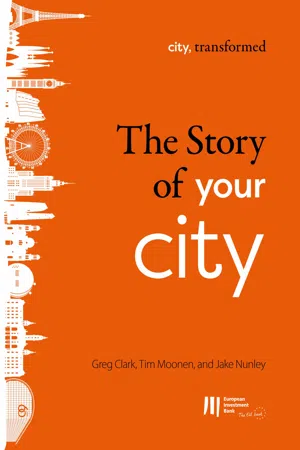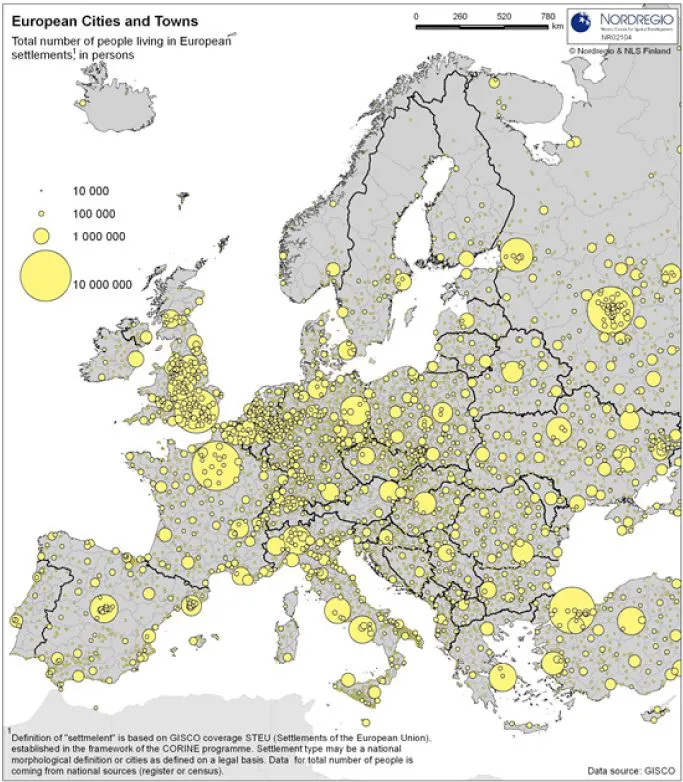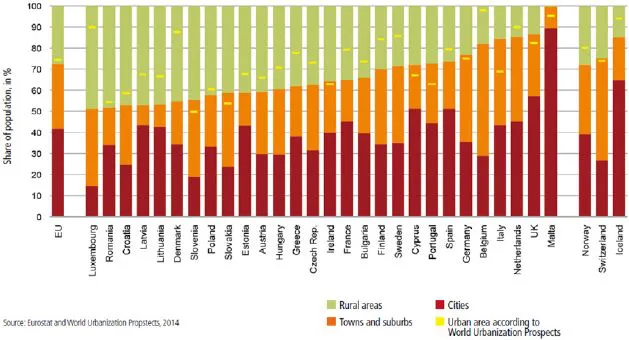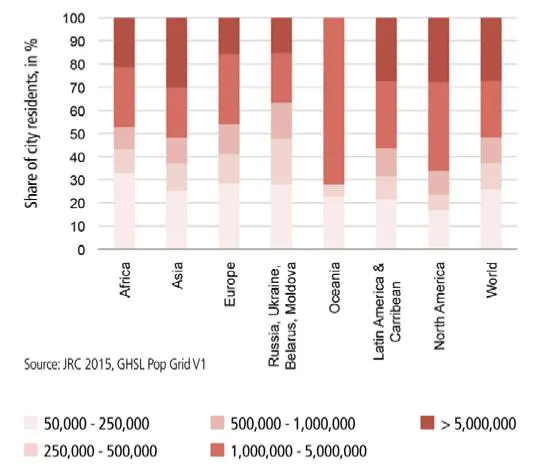
- 50 pages
- English
- ePUB (mobile friendly)
- Available on iOS & Android
eBook - ePub
The story of your city
About this book
By the end of this century, 9 out of 10 Europeans will live in an urban area. But what kind of city will they call home? You'll find all the answers in CITY, TRANSFORMED, the new essay series from the European Investment Bank. This panoramic first essay in the series lays out a great sweeping history of European cities over the last fifty years—and showcases new directions being taken by some of our most innovative cities. Urban experts Greg Clark, Tim Moonen, and Jake Nunley based at University College London take a definitive look at how Europe's cities transformed from post-industrial decline to thriving metropolises that are as prosperous and liveable as anywhere on Earth.
Frequently asked questions
Yes, you can cancel anytime from the Subscription tab in your account settings on the Perlego website. Your subscription will stay active until the end of your current billing period. Learn how to cancel your subscription.
At the moment all of our mobile-responsive ePub books are available to download via the app. Most of our PDFs are also available to download and we're working on making the final remaining ones downloadable now. Learn more here.
Perlego offers two plans: Essential and Complete
- Essential is ideal for learners and professionals who enjoy exploring a wide range of subjects. Access the Essential Library with 800,000+ trusted titles and best-sellers across business, personal growth, and the humanities. Includes unlimited reading time and Standard Read Aloud voice.
- Complete: Perfect for advanced learners and researchers needing full, unrestricted access. Unlock 1.4M+ books across hundreds of subjects, including academic and specialized titles. The Complete Plan also includes advanced features like Premium Read Aloud and Research Assistant.
We are an online textbook subscription service, where you can get access to an entire online library for less than the price of a single book per month. With over 1 million books across 1000+ topics, we’ve got you covered! Learn more here.
Look out for the read-aloud symbol on your next book to see if you can listen to it. The read-aloud tool reads text aloud for you, highlighting the text as it is being read. You can pause it, speed it up and slow it down. Learn more here.
Yes! You can use the Perlego app on both iOS or Android devices to read anytime, anywhere — even offline. Perfect for commutes or when you’re on the go.
Please note we cannot support devices running on iOS 13 and Android 7 or earlier. Learn more about using the app.
Please note we cannot support devices running on iOS 13 and Android 7 or earlier. Learn more about using the app.
Yes, you can access The story of your city by Greg Clark,Tim Moonen,Jake Nunley, European Investment Bank in PDF and/or ePUB format, as well as other popular books in Economics & Public Finance. We have over one million books available in our catalogue for you to explore.
Information
_____________
In the first of a series of essays on cities, we take a definitive look at how Europe’s cities transformed from post-industrial decline to thriving metropolises that are as prosperous and liveable as anywhere on Earth.
_____________
1. Prologue
1.1 Europe and the metropolitan century.
Europe’s cities are global leaders. Though they lack the clout that comes with ten million-plus populations or the headquarters of the world’s largest firms, on important international agendas such as cultural production, public health, knowledge and education, and sustainability, the European metropolis leads. Europe’s cities win on many measures of liveability and resilience, and these advantages are increasingly relevant in a world challenged by climate change, instability, and economic transition.
Figure 1: The distribution and relative size of European cities today

In this essay series, we will seek to reveal how Europe’s cities have emerged over the past fifty years, and what their prospects are. The world has entered an age of urbanisation, a metropolitan century, that is already one third complete. From roughly 1980 to 2080, humankind is on a great trek to the cities. By the time this century is complete, the world’s population will be 80% urbanised. Europe will be at the vanguard of this change, around 90% urbanised.
Within this metropolitan century we also expect to see human population growth tail off. A new generation of technologies will make living smarter, vehicles more autonomous, and work more automated. The great quest of our time – to address planetary warming and arrest climate change – will be played out through this urbanising century. How well we can use the new spatial concentration of people and activity, combined with machine learning and exponential technologies, to address key challenges of economic inclusion and planetary sustainability may well depend upon how our cities perform. Whether Europe’s cities have the tools and financing they need will in turn depend upon how capable and stable our political systems will be in addressing the challenges of dynamic capital markets, global insecurity, geo-political disruption, and populism.
With these sharp imperatives, Europe’s cities have become a critical platform for action and innovation. We start the story of these cities by asking how they have evolved and changed in the past fifty years. What have been the ingredients and recipes of urban transformation in Europe so far, and what part has investment played in helping our cities to adapt? Where has this transformative investment come from? And how can finance and investment know-how be applied into the future to help Europe’s cities make this new great urban trek successful and complete?
1.2 Europe’s cities: the past fifty years.
Observing the journeys that European cities have taken from 1970 to 2020 reveals some startling facts. Today, 72% of the EU28 population lives in cities and urban areas, but this average conceals pronounced differences between countries. Urbanisation rates vary from about 50% (Luxembourg, Romania, Croatia) to beyond 80% (Italy, Netherlands, UK). Closer examination also reveals a huge diversity in the sizes and types of European cities.
Figure 2: Share of urban population in EU and constituent countries as % of total

Europe’s urban system today consists of a mixture of small, medium-sized, and large cities, which can be seen to play distinctive roles and be at different points in their life cycles. By most definitions, Europe has no megacity. There is no single municipal area with more than 10 million people. But the wider city-regions of London, Paris, and Milan each have more than 10 million.
In 2012, the OECD and the European Commission reported that in the EU (plus Switzerland, Croatia, Iceland and Norway), there were 828 cities, including two global cities (London and Paris), six large urban centres in which the main city has around 3 million inhabitants (Athens, Berlin, Madrid, Barcelona, Milan and Naples), 18 second-tier metropolitan areas (1–2 million people), and 38 third-tier cities (500,000 to 1 million people). Of these third-tier cities, half are located in Germany, France and the UK. (The European Spatial Planning Observation Network defines first-tier cities as European capitals, and second-tier cities as “those cities outside the capital whose economic and social performance is sufficiently important to affect the potential performance of the national economy.”1 Some studies refine this definition, by making Zürich Switzerland’s first-tier city, for example, rather than Bern, or by recognising a city as first-tier if it has a larger GDP than its capital – e.g. Munich, Frankfurt, Milan and Barcelona.2 By all of these definitions, third-tier cities include all those cities not classified as second-tier.)
In Europe, cities with a population of below 250,000 account for 28% of city residents, lower than in Africa (33%), but higher than in North America (17%). Around 26% of residents live in cities with populations between 1 million and 5 million, and around 14% of Europeans live in cities with populations of over 5 million.
Figure 3: Share of urban population as % of total, by continent

Figure 4: Share of city residents as % of total population by continent

But Europe has not always been so urban. Indeed, the past fifty years have seen far-reaching changes to the way the European urban system is organised. During these five recent decades, Europe has effectively shifted from being an industrial and primarily rural continent to one that is urban and metropolitan in nature.
The continent’s 828 cities accounted for 37% of the population in 1961, growing to 40% in 1981 and remaining constant from there on, until more recent growth in the urban cores. Towns, suburbs, and the neighbouring areas, on the other hand, have consistently increased their population share over these five decades, due mainly to a combination of population moving out of the core cities into wider suburbs and urban regions, and from rural areas into towns. This process of shifts from rural to urban, core city to suburb, and single cities to neighbouring networks of locations has been accompanied by two other more recent trends of re-urbanisation, with substantial revitalisation happening in the cores of Europe’s cities, and metropolitanisation, the formal and informal processes of consolidation of neighbouring cities, suburbs, and towns into combined settlements with shared systems of transport and public services.
1.3 A European system of cities?
The 28 EU Member States entered the Union at different times and with their own distinctive and settled urban systems and hierarchies. Each country began its journey into Europe with a clear sense of how their cities worked together and what national urban systems underpinned their respective roles.
EU integration has opened up these settled urban systems to external influence in the form of trade expansion, population shifts, new connectivity modes, opportunities for economic specialisation, and cross-border interchange and collaboration. As the EU has evolved, Europe’s cities have adjusted to these new opportunities and positioned themselves within a much more open continental framework of an integrating Europe. As cities responded to new choices, opportunities, and connectivity, their adaptations have created a new phenomenon. There is now a clearly evolving European interdependent and polycentric system of cities, that co-exists with the ongoing national urban systems, which have themselves also become more dynamic as a result.
This new European system of cities is highly heterogenous, featuring not only the ongoing roles of the 28 capital cities, but also a larger range of diverse cities with unique specialisms (e.g. in advanced manufacturing, finance, professional services, creative industries, education, technology, ports and logistics, energy, tourism, health, or culture). Cities such as Munich, Rotterdam, Krakow, Gothenburg, Lyon, Manchester, Basel, Barcelona, Cork, Antwerp, Bologna and Oulu, are not the largest city or the capital city of their national urban system, but within the framework of EU integration they have seized the opportunity to become important specialist players on a European stage.
The new system also contains new urban conurbations that cross-national borders such as Vienna-Bratislava, Copenhagen-Malmo and Trieste-Ljubljana. There are macro-networks of cities that span historic empires (the Austro-Hungarian network), or geographic connectors such as seas (the Baltic Sea region and the Union for the Mediterranean), rivers (such as the Rhine-Ruhr and Danube regional networks of cities), and mountain ranges (such as the transalpine grouping of cities in Switzerland, France, and Italy).
Increasingly, there also are connected clusters of cities centred around advanced services, innovation, and creative economies that are bound together by flows of people, labour, capital and ideas. Groupings such as the northwest metropolitan core (Amsterdam, Brussels, Frankfurt, Paris, London) that contain and combine more than 70% of advanced transactions in the EU share a common corporate presence, mobile labour forces, and are increasingly serviced by integrated rail systems as well as high density aviation connections. The emerging cluster of Central European capitals (Berlin, Warsaw, Prague, Budapest, Vienna, Bratislava) provides an important opportunity for a powerful cluster of connected cities to host advanced activities, and the increasing cooperation and connectivity between Nordic cities (Oslo, Gothenburg, Stockholm, Malmo, Copenhagen) shows the ambition to foster a combined 10 million-person urban region through complementary specialisation and borrowed scale.
This new European System of Cities can also be observed to house different types of cities, among others:
• Western European large and capital cities, as points of centrality;
• Deindustrialising cities, which have recovered from crisis and reinvented themselves through investment;
• Mediterranean cities, which have invested in tourism and associated infrastructure and services; and
• Eastern and Central European cities, which have emerged from the collapse of...
Table of contents
- 1. Prologue
- 2. Europe’s cities: the past fifty years
- 3. The evolving European system of cities
- 4. How the system of cities evolved: adaptation and investment in European cities
- 5. Featured Cities in this series
- References